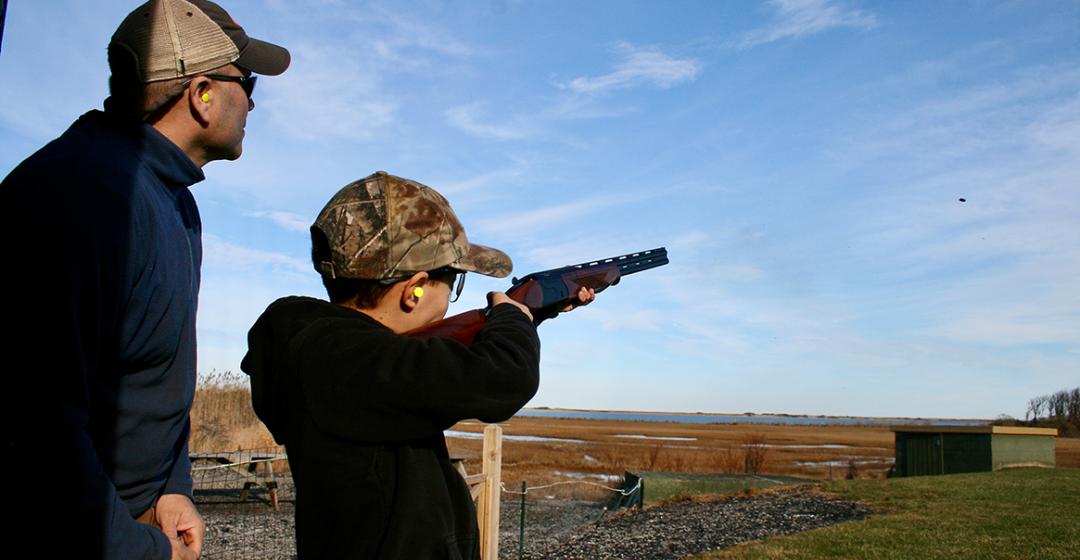“Pull,” Dick Carlson shouted as he leaned into the chill wind, his cheek firmly planted on the polished stock of a Beretta over-under shotgun. A black clay disk rocketed out the window of a shingled shed on the grounds of the Martha’s Vineyard Rod and Gun Club skeet field.
Carlson’s eyes stayed fixed on the “bird.” The blast of the shotgun sent a one-ounce stream of steel pellets on a trajectory calculated over the distance of a nerve synapse. The speeding sphere disintegrated mid-flight into a cloud of black dust against the backdrop of Sengekontacket Pond.
Carlson is a member of a dedicated fraternity that shoots skeet throughout the year. Heated vests and gloves replace shorts and sandals. Gusting winds are more of a challenge than a deterrent. When it snows, shooters shovel a path to the seven concrete pads, known as stations, from which they shoot at the twenty-five targets that make a round of skeet.
An Olympic sport, skeet originated in the 1920s when Charles Davis and William Harnden Foster of Andover, Massachusetts, developed a shooting game that would replicate upland game hunting for grouse, a speedy bird once abundant across Massachusetts. The name skeet is a derivative of the Norwegian word for “shoot.”
The course is set out in a semi-circle. A low house at one end and a high house at the other contain a mechanical launcher that propels a clay target about the diameter of a bread plate across the course at approximately fifty-five miles per hour. The angle and direction of the shot change as the shooters proceed from one station to the next. The challenge is to instinctively gauge the proper lead required to hit the target while swinging the shotgun in one fluid motion across the bird’s plane of travel.
Carlson, a skeet instructor and one of the club’s “top guns,” said he follows world champion Todd Bender’s three basic rules of skeet: “head on the gun, eye on the bird, proper lead, and you can’t miss.”
But missing the target is part of the game, particularly at the start. A friend introduced Brian Reed, seventy-one, of Oak Bluffs, a retired Martha’s Vineyard Hospital medical technologist, to the club’s skeet range about twenty years ago. “I’d never fired a shotgun and much less at a moving target,” he said. “My first one hundred shots were all misses. I think that might be a club record.”
Undeterred, Reed continued to improve. As evidence, that day on the range, the shell bag on his hip sports one of the small pins the club awards a member who shoots his or her first perfect round of twenty-five straight.
What’s the appeal? “It’s easy to do right and easy to do wrong, and it’s always a challenge to just do it right,” Reed said. “It takes willpower and concentration. You have to wipe everything out of your mind – meditation with a lot of noise.”
A group of Island waterfowlers and fishermen founded the club in 1911. In 1952, the club moved to its present home, a remote sixteen-acre parcel in Edgartown. The membership of nearly 500 seasonal and year-round residents, not all of whom shoot skeet, is a cross-section of Island life.
In the summer months, business executives shoot with building contractors and hunters with non-hunters. Engraved over-under Italian shotguns worth thousands of dollars stand in the gun rack next to production model pumps. “The key is they’re all skeet shooters,” said Carlson. That ties them together.”
For Edgartown Police sergeant Joel DeRoche, skeet is a natural extension of the love of the outdoors he shares with his daughters Georgia, thirteen, and Mabel, eleven.
On a clear fall day, DeRoche smiled as Georgia, an Edgartown School eighth grader, shouldered her shotgun under the watchful eyes of shooting instructor Brian Cioffi of Chilmark. “I’d always thought that once she reached this age, she wasn’t going to want to hang out with Dad anymore, and I come to find we are hanging out no less now than we did when she was younger.”
Cioffi’s fifteen-year-old son, Bryce, holding a Ruger Red Label over-under 20-gauge shotgun while waiting to take his turn on the range, said he likes the sport aspect of skeet. The high school sophomore said the challenge is mental. “Because you know you’ve hit every single bird on the course at one point or another in time, but psychologically it’s being able to do it every time.”
Instructor Cioffi follows some basic rules with young people: “Make it fun, make it enjoyable, add no pressure, and stress safety,” he said. “And you’ve got to have patience.”
Reed would like to see more young people and women enjoy the sport. He thinks some people might be under the mistaken impression that the shooters are a small, insular group. “That couldn’t be further from the truth,” he said. “Anyone who starts shooting skeet is going to get all kinds of tips and encouragement.
“We also stay well away from blue, red, religion, politics,” he added. “We don’t want to spoil it for anyone. You have to get around that stuff.”





